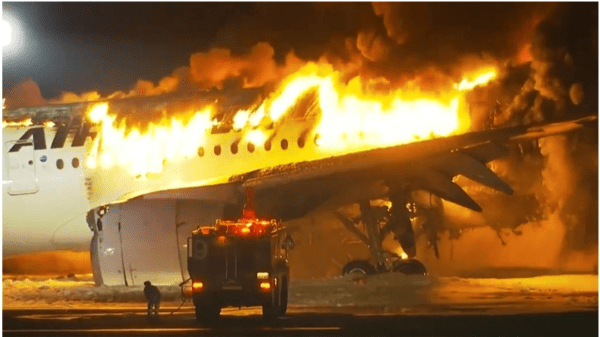Looking beyond the burning aircraft at Haneda – By GEORGE BRAINE

 Yesterday, as I watched, live on TV, the aircraft burning on Haneda airport’s tarmac, the thought that drove me crazy was “Where are the passengers? Are they still inside the aircraft?”
Yesterday, as I watched, live on TV, the aircraft burning on Haneda airport’s tarmac, the thought that drove me crazy was “Where are the passengers? Are they still inside the aircraft?”
I live in Sapporo, the capital of Japan’s northernmost island, and each time I leave Japan, I first take the 90-minute flight from Sapporo to Haneda or Narita, one of the airports in Tokyo. In fact, I had just returned home on December 26 after a trip to Sri Lanka. The burning aircraft had arrived from Sapporo, my hometown.
Later, we were told that all 367 passengers and 14 crew members had evacuated. Then, videos from inside the aircraft taken by passengers began to emerge. The aircraft was filled with smoke and some passengers were almost lying on the floor. A flight attendant, with a flashlight, was urging passengers to leave. The windows were lit up with the fires burning outside, a scene from hell. But, there was no panic; no one was opening the overhead bins to grab their carry-on bags, pushing other passengers aside, screaming their heads off, or arguing with the flight attendants.
Perhaps, this could have happened only in Japan. Over 40 years, I have taken a thousand flights on numerous airlines. I observe the behavior of flight attendants. Some thumb their noses at passengers, especially on those from poor countries. Some are haughty, assuming they are god’s gift to the passengers. The meal trays are not picked up even long after the meals are done. Even on long haul flights, the toilets are not cleaned regularly, and become horrors. Some attendants have arguments among themselves. Once, on a Sri Lankan flight, I overheard a supervisor berating a young flight attendant in filth; he assumed I was a foreigner who did not understand Sinhala.
Passenger behavior is no better. The most annoying are those who lean their seats back all the way, literally lying on the lap of the passenger behind them. Before the aircraft comes to a stop at the end of a flight, some passengers get off their seats and open the overhead bins to take their carry-on bags, a very dangerous practice. Others are loud talkers and become a nuisance. Some mess up the toilets, not giving a thought to other users.
On Japanese flights, most passengers watch videos on their phones, read, or nap. If at all, they speak in whispers. Barely anyone leans the seat back. The toilets are clean. The flight attendants make a special effort to speak to me in their often limited English.
On that ill-fated JAL 516 flight, I need not have worried about the passengers. Under the guidance of the flight attendants, who are trained to evacuate all passengers within 90 seconds, all 367 passengers got off safely. In fact, the aircraft was nose down, the tail lying at a higher angle. Passengers who used the third chute, at the back, had to walk up and then slide down a chute that was higher off the ground. But, everyone managed.
What happened was truly a miracle. It may have happened only in Japan, where the people are stoically polite and kind, and the culture is collective.
Those flight attendants deserve medals.







